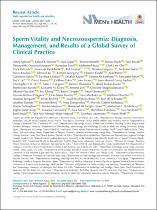| dc.contributor.author | Henkel, Ralf | |
| dc.contributor.author | Agarwal, Ashok | |
| dc.contributor.author | Sharma, Rakesh K | |
| dc.contributor.author | Gupta, Sajal | |
| dc.date.accessioned | 2022-08-08T08:34:10Z | |
| dc.date.available | 2022-08-08T08:34:10Z | |
| dc.date.issued | 2021 | |
| dc.identifier.citation | Agarwal, A. et al. (2021). Sperm vitality and necrozoospermia: Diagnosis, management, and results of a global survey of clinical practice. World Journal of Men's Health, 39 doi:10.5534/wjmh.210149 | en_US |
| dc.identifier.issn | 22874208 | |
| dc.identifier.uri | https://doi.org/10.5534/wjmh.210149 | |
| dc.identifier.uri | http://hdl.handle.net/10566/7716 | |
| dc.description.abstract | Sperm vitality testing is a basic semen examination that has been described in the World Health Organization (WHO) Laboratory Manual for the Examination and Processing of Human Semen from its primary edition, 40 years ago. Several methods can be used to test sperm vitality, such as the eosin-nigrosin (E-N) stain or the hypoosmotic swelling (HOS) test. In the 6th (2021) edition of the WHO Laboratory Manual, sperm vitality assessment is mainly recommended if the total motility is less than 40%. Hence, a motile spermatozoon is considered alive, however, in certain conditions an immotile spermatozoon can also be alive. Therefore, the differentiation between asthenozoospermia (pathological decrease in sperm motility) and necrozoospermia (pathological decrease in sperm vitality) is important in directing further investigation and management of infertile patients. The causes leading to necrozoospermia are diverse and can either be local or general, testicular or extra-testicular. The andrological management of necrozoospermia depends on its etiology. However, there is no standardized treatment available presently and practice varies among clinicians. In this study, we report the results of a global survey to understand current practices regarding the physician order of sperm vitality tests as well as the management practices for necrozoospermia. Laboratory and clinical scenarios are presented to guide the reader in the management of necrozoospermia with the overall objective of establishing a benchmark ranging from the diagnosis of necrozoospermia by sperm vitality testing to its clinical management. | en_US |
| dc.language.iso | en | en_US |
| dc.publisher | Korean Society for Sexual Medicine and Andrology | en_US |
| dc.subject | Asthenozoospermia | en_US |
| dc.subject | Eosine Yellowish-(YS) | en_US |
| dc.subject | Infertility | en_US |
| dc.subject | Nigrosin | en_US |
| dc.subject | Spermatozoa | en_US |
| dc.title | Oxidative stress: A comprehensive review of biochemical, molecular, and genetic aspects in the pathogenesis and management of varicocele | en_US |
| dc.type | Article | en_US |

